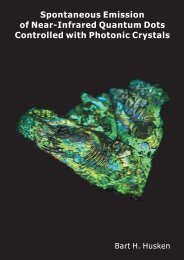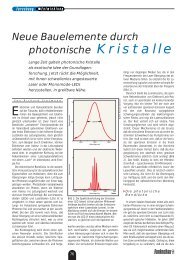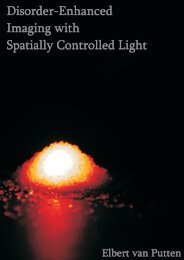Location of objects in multiple-scattering media - COPS
Location of objects in multiple-scattering media - COPS
Location of objects in multiple-scattering media - COPS
You also want an ePaper? Increase the reach of your titles
YUMPU automatically turns print PDFs into web optimized ePapers that Google loves.
1210 J. Opt. Soc. Am. A/Vol. 10, No. 6/June 1993<br />
stationary diffusion equation with boundary conditions<br />
given by the geometry <strong>of</strong> the scatter<strong>in</strong>g medium and extra<br />
boundary conditions from the embedded object. We consider<br />
a slab geometry and a spherically shaped geometry.<br />
The slab is situated between x = L and x = 0 and is <strong>in</strong>f<strong>in</strong>itely<br />
extended <strong>in</strong> the yz plane. A source S(y, z), plane<br />
wave or po<strong>in</strong>tlike, is placed at x = L. The sphere that<br />
conf<strong>in</strong>es the scatter<strong>in</strong>g medium is centered at the orig<strong>in</strong>.<br />
The stationary diffusion equation reads as<br />
AI(r) = 0. (1)<br />
The boundary conditions at the outer surfaces <strong>of</strong> the medium<br />
are for a slab<br />
and for a sphere<br />
I(L, y, z) = S(y, z), I(0, Y, z) = (2)<br />
I(R, 0, ) = S(O, ), (3)<br />
where I(r) is the diffuse <strong>in</strong>tensity, L is the thickness <strong>of</strong> the<br />
slab, and R is the radius <strong>of</strong> the sphere.<br />
One can dist<strong>in</strong>guish at least two means <strong>of</strong> absorption by<br />
the object: uniform absorption <strong>in</strong> its volume or absorption<br />
only at its surface. Absorption at the surface could<br />
be used, for <strong>in</strong>stance, as a model for dyed polystyrene<br />
spheres. For uniform absorption an absorption length<br />
la1 = /K can be <strong>in</strong>troduced, and for the <strong>in</strong>tensity <strong>in</strong>side the<br />
object the diffusion equation<br />
AI(r) = K 2 1(r) (4)<br />
should be considered. In this case the problem is to solve<br />
Eqs. (1) and (4), together with the boundary condition<br />
given by Eq. (2) or (3) and with extra boundary conditions<br />
on the surface <strong>of</strong> the object that are given by<br />
Iut(a+) = Ii(a-), (5)<br />
D a-|ut = D2 ~ -| (6)<br />
an a+<br />
The diffusion constants Di and D 2 are for the medium and<br />
for <strong>in</strong>side the object, respectively. The normal derivative<br />
a/an is taken on the surface <strong>of</strong> the object. Equation (5)<br />
provides cont<strong>in</strong>uity <strong>of</strong> <strong>in</strong>tensity, and Eq. (6) conserves the<br />
flux through the boundary <strong>of</strong> the object. These boundary<br />
conditions follow from the underly<strong>in</strong>g transport theory,<br />
which yields both the diffusion equation and its boundary<br />
conditions.<br />
To account for absorption only at the boundary <strong>of</strong> the<br />
object, one modifies Eq. (6) such that the flux is not conserved.<br />
In this way absorption takes place at the boundary<br />
<strong>of</strong> the object, and we can use Eq. (1) for the <strong>in</strong>tensity<br />
<strong>in</strong>side the object. The modified boundary conditions are<br />
D aI-<br />
An +<br />
= D2 al<strong>in</strong> +aIi(a).<br />
An a<br />
The absorption parameter a has the dimension <strong>of</strong> speed<br />
(7)<br />
We can dist<strong>in</strong>guish a number <strong>of</strong> relevant cases. For<br />
<strong>in</strong>stance,<br />
or = K = 0, D2 O D,:<br />
a = K = 0, D2 = :<br />
a 0, or K 0:<br />
pure scatterer, no absorption,<br />
glass object or air bubble,<br />
absorber, absorb<strong>in</strong>g behavior<br />
dom<strong>in</strong>ates scatter<strong>in</strong>g.<br />
S<strong>in</strong>ce Eq. (1) is a Laplace equation, we can use the<br />
formalism <strong>of</strong> electrostatics and <strong>in</strong>troduce the analog <strong>of</strong><br />
charges, dipoles, and their mirror images. Positive<br />
charges describe light sources and negative sources describe<br />
absorption <strong>of</strong> light. Dipoles describe scatter<strong>in</strong>g<br />
<strong>objects</strong>.<br />
A. Three-Dimensional Slab<br />
We consider a plane wave S(L, y, z) = Io <strong>in</strong>cident upon a<br />
slab. A schematic view is given <strong>in</strong> Fig. 1. A spherical<br />
object with radius a is located at ro = (x 0, 0,0). We must<br />
write the potential for a po<strong>in</strong>t charge and apply the boundary<br />
condition given by Eq. (2), with S(y, z) = 0. This results<br />
<strong>in</strong> a summation over mirror images, the outcome<br />
be<strong>in</strong>g the diffusion propagator for a slab. The potential<br />
for a dipole can easily be obta<strong>in</strong>ed from this result if one<br />
takes the derivative with respect to the position <strong>of</strong> the<br />
charge. The <strong>in</strong>tensity <strong>in</strong> the slab can be expressed as<br />
1 1<br />
L I~r = IoL + Jr |ro + 2Lnx|' Jr + r + 2Ln52|<br />
P nE -[(X -<br />
x - x + 2nL<br />
xo + 2nL) 2 + p2 ] 3 / 2<br />
x + x + 2nL<br />
[(x + x + 2nL) 2 + 2]312'<br />
with x be<strong>in</strong>g a unit vector along the x axis and p 2 =<br />
y 2 + z 2 .<br />
The first term <strong>in</strong> Eq. (9) describes the undisturbed <strong>in</strong>tensity,<br />
the second term represents the effect <strong>of</strong> absorption<br />
analogous to a charge <strong>in</strong> electrodynamics, and the<br />
I<br />
0.' .<br />
L<br />
.<br />
Den Outer et al.<br />
Fig. 1. Schematic view <strong>of</strong> a <strong>multiple</strong>-scatter<strong>in</strong>g system with an<br />
embedded spherical object. The scatter<strong>in</strong>g system is characterized<br />
by a diffusion constant DI and the object by radius a, diffusion<br />
constant D 2, and absorb<strong>in</strong>g parameter a. A plane wave is<br />
<strong>in</strong>cident at x = L. The <strong>in</strong>tensity is derived at x = 0 and x = L.<br />
(9)









